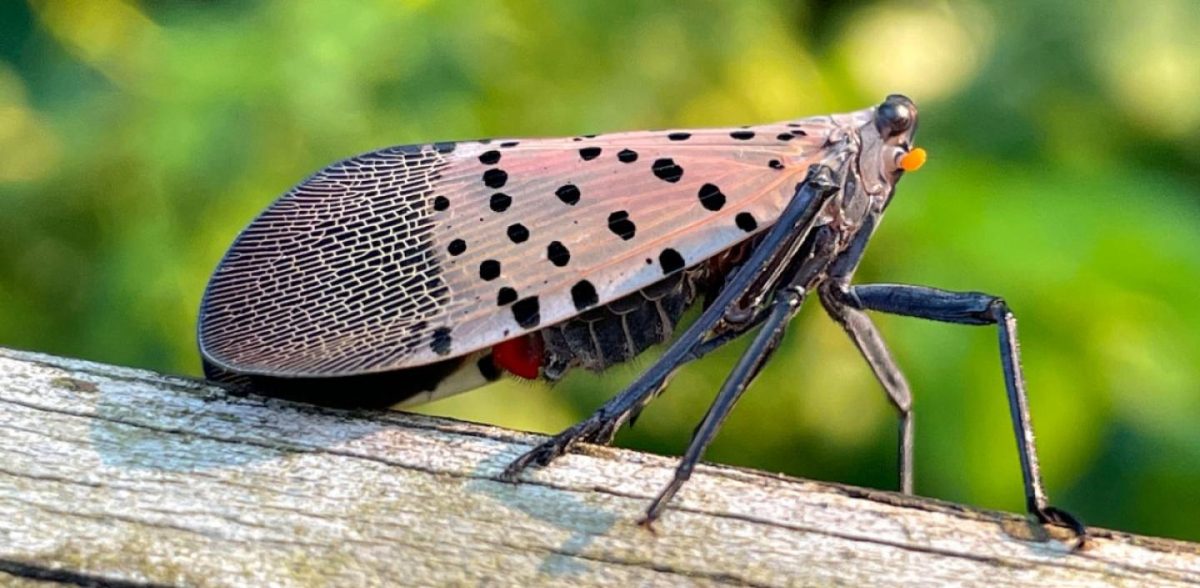Whether perched on a blade of grass, crawling up a tree trunk, or fleeing from a stomping foot, the Spotted Lanternfly has become an all too common sight in the Larchmont-Mamaroneck community. The species was first identified in the U.S. in 2014 in Pennsylvania. According to Hillary Jufer, the Horticulture Program Manager of the Cornell Cooperative Extension of Westchester County, populations of the Spotted Lanternfly arrived in Westchester in 2021. However, an anonymous employee of the New York Department of Agriculture and Markets stated, “We considered Westchester generally infested…around June of this year.”
Jocelyn Kleinman, the Director of Education at Sheldrake Environmental Center, corroborated, “While gardening this May in our Giving Garden at Sheldrake, we started noticing the Spotted Lanternfly nymphs…Our garden sightings grew and were most numerous in mid-summer.”
The life cycle of the Spotted Lanternfly is split into several stages: the egg stage, instar nymph stages, and adult stage. Now, in September, most lanternflies are flying adults. It may seem as though the population drastically increased throughout the summer months, but, Jufer explains, “if you look at their lifecycle, the first instar from May to June is very small, so it commonly goes unnoticed, but as they get bigger, people notice them more.”
Many MHS students, alarmed by the recent infestation, have been taking measures to reduce the species’ population. Rea Milo (‘25) commented, “I think the infestation has gotten really bad. You go out, and you see tons of them outside. I think everybody should be going outside and stomping on them.”
Unfortunately, the population is not expected to decrease in the upcoming months. Jufer asserts that “next year we will see more.” Adults will begin laying egg masses soon, students can expect to begin seeing them on trees, outdoor furniture, cars, stones, and just about any other outdoor object this week. Jufer notes that “common trees they prefer are silver maple, willow, and red maple,” as well as their most favored tree, the tree of heaven.
Going forward, students will be able to decrease the infestation not only by squashing adult lanternflies, but also by killing egg masses. To kill them, Jufer advises “[using] a credit card, or anything hard, to scrape [off the egg masses], “[putting] the egg masses in a bag of hand sanitizer or rubbing alcohol, … [squishing] [the bag] to make sure they are dead,” and throwing out the bag.
In the upcoming fall and winter months, the adult Spotted Lanternflies will disappear. In December, after the first hard freeze, the adult population should completely die. Although the winter will be a welcome respite from the adult lanternflies, the eggs laid by this September’s adults will hatch in May, initiating an even larger infestation. Despite human efforts, the population will be larger this spring, since this past summer featured the largest adult population the county has ever seen.
Jufer predicts that “[the infestation] will likely get worse before it gets better. They noticed in Pennsylvania that after 2-3 years of infestation the numbers did decline based on a few factors.” She also points out that in order to control the population growth more meticulously, efficient management tools, such as vacuums, insecticides, and circle traps, are being employed more widely.
During a group interview, Angus Queen (‘25) and Jack Queen (‘24), recalled seeing large numbers of lanternflies on their Cross Country runs. Angus commented on the enormous, startling scale of the infestation: “The biggest issue I have with them is that they’re all over the place, you see them everywhere. It’s almost like a jump scare, you walk to your front door, and there it is! Aside from that, it’s crucial that we get this invasive species under control, it’s really bad.…It destroys hardwood trees…it destroys entire vineyards.”
As the infestation worsens, the lanternflies will devastate crops and trees, and excrete sticky honeydew that is hard to remove and can lead to sooty mold. Jufer cites grapes as one of the most vulnerable plants: “A vineyard can see catastrophic failure of grapes in a season; I’m talking complete devastation.” Jufer points out that the economic implications of the infestation will be incredibly severe: “New York has 470 wineries across the state, 900 grape farms, about 35,000 acres of vineyards with over 5 million visitors per year. This is roughly $6.6 billion in direct economic impact to New York State.”
For now, doing your part to remove egg masses is an important remedy for the impending population rise next spring. However, a larger effort from environmental groups across the state will be required to truly manage the infestation.










